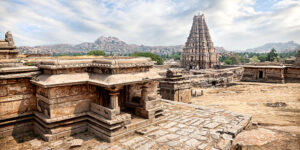There is a well-known, much celebrated Hindu adage. It is often engaged as a Hindu way of understanding the diversity of religious traditions in the world. This adage is often worded in the following way: “Truth is one. Paths are many.”[i] Another rendering of this adage goes like this: “Truth is one. Sages call it by many names.” And there could easily be variations of either of these renditions.
What is important to note here is the essential message most likely intended by these types of renderings: There is something that unifies human beings in their many ways (as in “paths are many”) of grasping the one ultimate reality (as in “truth is one”). A more precise or strict translation of the original source of these sayings, which is originally located in the Vedas, reveals this very intention quite clearly:
ekaṁ sad viprā bahudhā vadanti
There is one (ekam) Reality (sat)
about which vibrant persons (viprā)
in various ways (bahudhā) speak (vadanti).[ii]
Clearly differences between the popular renditions of this passage and the direct translation that I provide here are obvious. For example, no words such as “names” or “paths” exist in the original Sanskrit of this passage. But the intention, I believe, is to be expressing what the passage says most literally. Thus from the earliest sacred writings of India one finds this wise vision that has certainly been a powerful influence on traditions typically grouped under the umbrella term, Hinduism. And included in that group would obviously include the Chaitanya school of Vaishnavism.
This Vedic passage presents essential components for setting the stage for dialogue and the revelational gifts that can come from it: (1) There is “one reality” in which we all find ourselves, no matter what our faith orientation may be. Everything exists together in this one totality of reality no matter what religious truth we may hold as absolute, whatever we believe or claim as truth—or that which is closest to our hearts. Whatever exists is contained within this “one reality” which, in Sanskrit, is ekaṁ sat. (2) Persons who directly experience a connection or a relationship with that one reality become viprā (literally “shaking”) or “vibrant persons.” Such deeply inspired persons shake or vibrate in their experience or relationship with the divine as the absolute truth. This experience can consist of (a) that one reality revealing something of itself to such persons, or (b) something of that one reality as being reached or attained by such persons, or (c) a combination of the two. (3) Following from such an experience, persons are moved to share what has so deeply moved them or inspired them by “speaking” about that divine relationship with the one Reality that constitutes their “the absolute truth.” Speaking about the absolute truth to whom? These inspired persons share through dialogue their experience with either (a) persons who also participate in something of their vision of that absolute truth, or (b) persons who do not participate in their own vision but are nonetheless moved by their relationship with the one Reality that constitutes a different vision, a different “the absolute truth.” (4) The fullness of the one reality is such that there is no end to the experiences that such inspired persons can have of it, and thus the “various ways” of speaking about their relationships with the one Reality are endless.
Partners in dialogue will utilize whatever ways can best express this ultimate relationship. Each way of expressing it is unique, whether it be within a tradition or between traditions. And what is implied here is that the more such inspired or vibrant persons share with one another their experiences of the one Reality, the more that this very sharing itself through dialogue becomes the special way of uniting human hearts. What will invariably emerge between partners in such a dialogue is the special kind of revelation of the one Reality that cannot be found anywhere else. The Rig Vedic passage thus reveals the unique form of revelation of the one Reality that should be the very basis of dialogue and the very ground on which a genuine religious pluralism is built, and further, expresses an interfaith ethos that forms a foundation on which the Chaitanya school’s vision of dialogu and bhakti rests.
The word bahudhā in the famous Rig Vedic passage presented above, which I have translated there as “in various ways,” should be more closely examined. This word, which can mean, “in many ways,” “in many parts,” “in many forms,” “manifoldly,” etc., is significant.[iii] Humans speak about the one reality in various ways, in many forms, etc., because humans have different ways of relating to the one Reality. Simply, and interpreted for our purposes here, each of us has a specific and unique relationship with the one Reality. This relationship is absolute because it is connected to the absolute reality. It is also absolute because it is the ultimate way each of us relates to the absolute. A key verse of the Bhagavad Gītā affirms the notion that there are is an endless variety of relationships that can be reciprocated and accommodated by the divine Reality:
In the way they offer themselves to me, in just that way I offer my love to them reciprocally.
Human beings follow my path universally, O Pārtha.[iv]
Moreover, these many forms or ways each constitute the “the” that immediately precedes the word “truth,” expressing the singular exclusive vision within a relationship of the one Reality for each and every person. And thus the Vedic adage can be seen as anticipating the well-known Upanishadic phrase, raso vai saḥ, or “Rasa truly is that (Reality).”[v]
For the Chaitanya school, rasa, is ultimate reality, or the relationship with the one Reality as person. That relationship which connects humans to the one true Reality, imbuing it with absolute value or truth, is rasa. “The truth” of religious traditions, that exclusive absolute truth of religion, rests in this very notion of rasa with the one reality. A revision of the popular renditions of the passage from the Rig Veda examined above, then, might read as, “The totality of all reality is one. Religious truths (or rasas) are many.”[vi]
Though there are specifically five general types of rasas according to the Chaitanya school,the word rasa could be broadened and opened up to whatever one experiences and knows in a relationship with the one Reality. It is precisely because of rasa, therefore,that humans speak in many ways about the one Reality. In genuine dialogue, it would be precisely on the nature and experience within this rasa that would be shared between humans who experience rasa, thus disclosing a unique revelation. The extent to which this intra-faith dialogue takes place between humans and the divine determines the extent to which humans can offer themselves in inter-faith dialogue with other humans. When intrafaith dialogue is deep, then one becomes lifted up by dialogue into an even greater experience of Reality in which a shared state of elevated consciousness and the intimate connection of hearts is experienced between souls.
———————————————————————————————————————————————————————————————————-
[i] One of the most celebrative presentations of this Vedic adage can be observed at Satchidananda Ashrama, Yogaville, founded by Swami Satchidananda in Buckingham, Virginia, where he built the Light Of Truth Universal Service (LOTUS) temple that celebrates all religions. This Vedic passage is prominently displayed there and appears in the literature of the sect.
[ii] Rig Veda 1.164.46. Translation mine.
[iii] Sanskrit-English Dictionary, by Sir Monier Monier-Williams (Oxford: Oxford University Press, 1899).
[iv] Bhagavavd Gītā 4.11. Note the word “path” in the singular, contrasting the popular notion of “paths are many.”
[v] Taittirīya Upanishad 2.7.1. See my co-authored article with David Buchta, “Rasa Theory,” in the Brill Encyclopedia of Hinduism (ed. by Knut Jacobsen) for a concise history of the word rasa and how its usage culminates in the Chaitanya school in the word of Rūpa Gosvāmin. The more complete translation surround this passage is the following: “Because truly that existence is auspiciously formed, rasa truly is that existence; for once one here reaches that rasa, this person becomes completely blissful.”
[vi] Here I present a rendition that follows the syntax of the popular renditions mentioned above, which present the Vedic adage as two sentences. If this same rendition offered here were to be more syntactically accurate, keeping “the one reality” phrase as the object by utilizing the passive voice, it would read, “The one totality of all reality is that which is revealed through many religious truths.”



